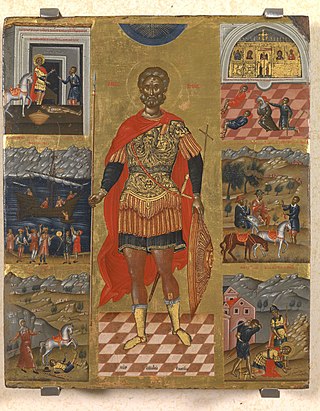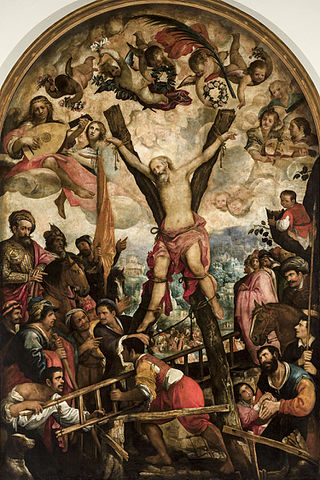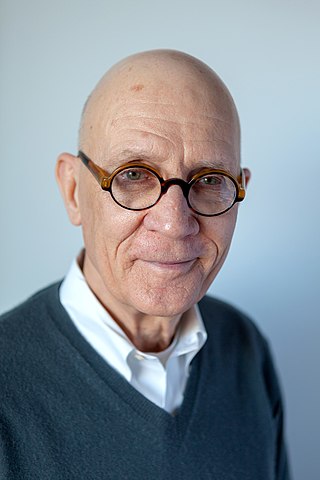Related Research Articles

Diego Rodríguez de Silva y Velázquez, Knight of the Order of Santiago was a Spanish painter, the leading artist in the court of King Philip IV of Spain and Portugal, and of the Spanish Golden Age.

Domḗnikos Theotokópoulos, most widely known as El Greco, was a Greek painter, sculptor and architect of the Spanish Renaissance. El Greco was a nickname, and the artist normally signed his paintings with his full birth name in Greek letters, often adding the word Κρής, which means "Cretan".

Chiaroscuro, in art, is the use of strong contrasts between light and dark, usually bold contrasts affecting a whole composition. It is also a technical term used by artists and art historians for the use of contrasts of light to achieve a sense of volume in modelling three-dimensional objects and figures. Similar effects in cinema, and black and white and low-key photography, are also called chiaroscuro.


The Burial of the Count of Orgaz is a 1586 painting by El Greco, a prominent Renaissance painter, sculptor, and architect of Greek origin. Widely considered among his finest works, it illustrates a popular local legend of his time. An exceptionally large painting, it is divided into two sections, heavenly above and terrestrial below, but it gives little impression of duality, since the upper and lower sections are brought together compositionally.
El Greco (1541–1614) was a prominent painter, sculptor and architect active during the Spanish Renaissance. He developed into an artist so unique that he belongs to no conventional school. His dramatic and expressionistic style was met with puzzlement by his contemporaries but gained newfound appreciation in the 20th century.

Cretan School describes an important school of icon painting, under the umbrella of post-Byzantine art, which flourished while Crete was under Venetian rule during the Late Middle Ages, reaching its climax after the Fall of Constantinople, becoming the central force in Greek painting during the 15th, 16th and 17th centuries. The Cretan artists developed a particular style of painting under the influence of both Eastern and Western artistic traditions and movements; the most famous product of the school, El Greco, was the most successful of the many artists who tried to build a career in Western Europe, and also the one who left the Byzantine style farthest behind him in his later career.

El Greco, 1541 – April 7, 1614) was a prominent painter, sculptor and architect of the Spanish Renaissance, whose dramatic and expressionistic style was met with puzzlement by his contemporaries but found appreciation in the 20th century.

Juan de Roelas, de las Roelas or Ruela was a Flemish painter whose entire documented career took place in Spain. He played a major role in the transition from Mannerist to Baroque painting in Spain.

A modello, from Italian, is a preparatory study or model, usually at a smaller scale, for a work of art or architecture, especially one produced for the approval of the commissioning patron. The term gained currency in art circles in Tuscany in the fourteenth century. Modern definitions in reference works vary somewhat. Alternative and overlapping terms are "oil sketch" (schizzo) and "cartoon" for paintings, tapestry, or stained glass, maquette, plastico or bozzetto for sculpture or architecture, or architectural model.

Two Old Men, also known as Two Monks or An Old Man and a Monk, are names given to one of the 14 Black Paintings painted by Francisco Goya between 1819-23. At the time Goya was in his mid-seventies and was undergoing a great amount of physical and mental stress after two bouts of an unidentified illness. The works were rendered directly onto the interior walls of the house known as Quinta del Sordo, which Goya purchased in 1819.

Saint Luke is a painting by an artist known as El Greco. The painting is an oil on canvas created sometime around 1610-1614. It is currently held by the Indianapolis Museum of Art in Indianapolis, Indiana.
Jonathan Mayer Brown was an American art historian, known for his work on Spanish art, particularly Diego Velázquez. He was Carroll and Milton Petrie Professor of Fine Arts at New York University.

The El Greco Museum is located in Toledo, Spain. It celebrates the mannerist painter El Greco, who spent much of his life in Toledo, having been born in Fodele, Crete.

View and Plan of Toledo is a landscape painting by El Greco. The image is notable for its juxtaposition of the view of Toledo with the trompe l'oeil map of the city's streets. In the composition, El Greco also included an allegory of the Tagus River, a scene of the Virgin Mary placing a chasuble on Saint Ildefonsus, and an elevation of the Tavera Hospital floating on a cloud. It was probably originally commissioned by Pedro Salazar de Mendoza and is currently preserved in the El Greco Museum in Toledo, Spain.
Cambridge Studies in the History of Art is a book series of the history of art published by Cambridge University Press. The editors were Francis Haskell, a fellow of King's College, Cambridge, and Nicholas Penny of the National Gallery. The first volume in the series was El Greco and his patrons: Three major projects by Richard G. Mann, published in 1986, in which Mann investigated three of El Greco's six major projects and the patrons responsible for them.
The Collections of the National Gallery of Art Systematic Catalogue is a project of the National Gallery of Art, Washington, to publish a comprehensive catalogue of the paintings, sculpture, and decorative arts in the gallery's collection.

Saint Sebastian, or Martyrdom of Saint Sebastian is an autograph work by the famed artist Doménikos Theotokópoulos, commonly known as El Greco. It shows the Martyred Saint in an atypical kneeling posture which has led some scholars to believe it to be a compositional quotation of various works by other great masters whom the artist admired. The painting is currently on display in the Palencia Cathedral.

Allegory of the Camaldolese Order is a composition by El Greco and his workshop that survives in two paintings, one at the Instituto Valencia de Don Juan in Madrid and the other at the Museo del Patriarca in Valencia. The paintings depict a bird's-eye view of the "ideal monastery" according to the Camaldolese, and were likely commissioned as part of Fray Juan de Castañiza's petition to Philip II in 1597 to establish the benedictine monastic order in Spain.

William Bryan Jordan Jr. was an American art historian who facilitated acquisitions, curated exhibitions, and authored publications on Spanish artists and still life paintings, particularly from the Golden Age.
References
- ↑ https://bulletin.sfsu.edu/faculty/emeritus-emerita/
- ↑ Faculty Directory (M - Z). San Francisco State University. Retrieved 12 December 2016.
- 1 2 "Review: El Greco and his Patrons: Three Major Projects by Richard G. Mann" Review by Priscilla E. Muller, Renaissance Quarterly , Vol. 40, No. 3 (Autumn, 1987), pp. 538-540.
- ↑ Spanish Paintings of the Fifteenth through Nineteenth Centuries. National Gallery of Art. Retrieved 17 December 2016.
- 1 2 "Spanish Paintings of the Fifteenth through Nineteenth Centuries by Jonathan Brown and Richard G. Mann", review by James Clifton, The Sixteenth Century Journal , Vol. 23, No. 4 (Winter, 1992), pp. 810-811.